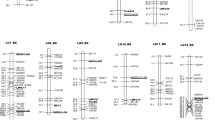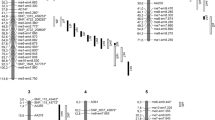Abstract
A map of flax (Linum usitatissimum) using restriction fragment length polymorphisms (RFLPs) and random amplified polymorphic DNAs (RAPDs), and comprising 15 linkage groups containing 94 markers, has been developed covering about 1000 cM. The mapping populations were the F2 populations from two crosses between diverse cultivars. From one cross, CI1303 and Stormont Cirrus, 20 RFLP and 520 RAPD markers were analyzed. Thirteen RFLP and 80 RAPD markers were on the 15 linkage groups, in addition to one sequence-tagged site (STS). Seven polymorphic RAPD markers were found to have unusual segregation patterns. RAPDs were expressed as dominant markers, but for these markers a prevalence of the progeny lacked a band rather than the expected one-fourth ratio. However, these exceptions may be related to the instability of the genome of Stormont Cirrus in which stable and heritable genomic changes can be induced by environmental factors. The current map could be used for the identification of markers linked to loci controlling the ability to generate heritable changes in response to environmental growth conditions, and to develop anchor loci with STSs for a more general application.
Similar content being viewed by others
Author information
Authors and Affiliations
Additional information
Received: 20 March 1999 / Accepted: 16 December 1999
Rights and permissions
About this article
Cite this article
Oh, T., Gorman, M. & Cullis, C. RFLP and RAPD mapping in flax (Linum usitatissimum). Theor Appl Genet 101, 590–593 (2000). https://doi.org/10.1007/s001220051520
Issue Date:
DOI: https://doi.org/10.1007/s001220051520




